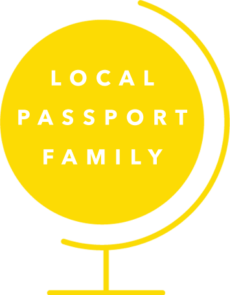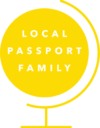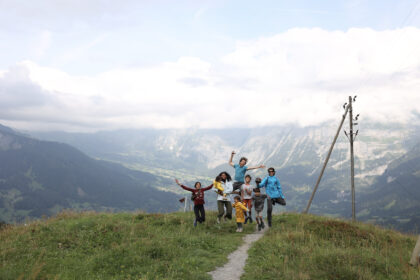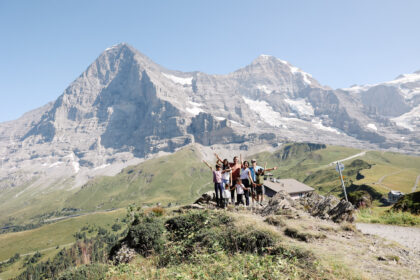During our trip driving from California to Alaska, we experienced driving across the US/Canada border with kids a number of times. If you’re wondering, “what is it like crossing the Canadian border?” then this is the post for you! In general, it’s a pretty easy and straightforward border crossing for US citizens, but there are a few things that will make it easier, faster, and smoother.
Here are 10 tips for driving across the US/Canada border, especially with kids!

Download and Fill out the ArriveCAN App in Advance
The most important thing you can do to make for a smooth border crossing when driving across Canadian border is to fill out the ArriveCAN app in advance (if you’re driving into Canada). Your whole family can be inputted into one login – there’s no need to create a different account for each person. This is important to do because the border agent can deny you crossing if you don’t fill it out in advance.
The app is where you’ll include information about the dates and duration of your stay, personal document numbers, vaccination status, and more. After you fill it out, you’ll receive a QR code that you can either print out or just show on your phone to the border agent when you hand over your identification documents.
Keep in mind that you must fill out ArriveCAN EACH time you cross the border into Canada. So if you go back and forth across the border a few times, even during a single trip or within a few days (or the same day), you still need to fill out ArriveCAN for each crossing.
Have Documents Ready
Even after filling out the ArriveCAN app, you’ll still need to present your physical documents at the border. Be sure to have them ready and accessible. We like to keep all of our passports in this zip up passport case that fits all of them for our whole family.
The US State Department website shares, “Canadian law requires that all persons entering Canada carry proof of citizenship and identity. A valid U.S. passport, passport card, or NEXUS card satisfies these requirements for U.S. citizens. Children under 16 only need proof of U.S. citizenship.” These are the documents that work for children: U.S. or Canadian passport, original or copy of birth certificate, naturalization certificate, Canadian citizenship card, or consular report of birth abroad.
If you’re staying in Canada for longer than 180 days, you will need a tourist visa, as well.
Some countries will require passport validity for 6 months after the date of entry, but Canada just requires validity at the time of entry. They also require at least one blank passport page.
Check Border Opening/Closing Times
At one point during our journey, we took an overnight ferry that docked at around 2:30am. Since we’d slept on board, we figured we’d just drive a couple hours to our RV just across the border in Canada and go back to bed for a bit. We were surprised that the border didn’t open until 7am Alaska time, 8am Yukon time! There were several other cars in line, as well, so we just turned off our engine and fortunately everyone slept in the car for a bit until the border opened (and we were glad we weren’t going the other direction as it would’ve taken another 2 hours).
At another point, we noticed a border crossing that had a hard close of 6pm and wouldn’t necessarily even let those in line through after that. It’s definitely worth checking the opening times of your particular crossing location in advance and leaving plenty of time to get across.
Know Your License Plate Number
The border agents will likely ask for your license plate number. To make it easier for them and you, either know it off the top of your head, or just tape a piece of paper to your dash with the number written down.
Know in Advance What You’re Bringing Across the Border
Even if you don’t have any major purchases to declare, you should have a good idea of anything you bought – especially when it comes to food. Certain fruits and vegetables may need to be inspected, so make sure you’re aware of what is in your vehicle so you can tell the border agent. It will make the process easier if you’re familiar with and confident with what you’re transporting. You should also be familiar with any prohibited or restricted items when it comes to border crossings. There’s more info on what is allowable here and here.
Declare Bear Spray
Bear spray deserves its own category because I’ve heard of issues with not declaring it in advance. It’s an important item to have when in bear country, but make sure you properly declare.
Clearly labeled bear spray is fine to take across the border both ways, but be sure to let them know you have it as it is a hazardous item. You definitely don’t want them to find out you have it without you saying something as you could be hit with a large fine. Also, make sure you have actual bear spray and not pepper spray or something of the like. (This is the kind of bear spray that we have with this holster when hiking.)
Try to Avoid Peak Times
Weekends and holidays will inevitably be much busier than weekdays, so try to avoid them if you can. Both the US Customs and Border Protection and Canadian border agency provide info on current wait times if you’d like to check in advance.
Have your COVID-19 vaccinations up to date
Right now, travelers ages 18 and older are required to provide proof of COVID-19 vaccination or undergo testing and quarantine periods. The rules are a bit different for kids under age 12.
Kids under age 5 aren’t subject to any vaccination, testing, or quarantine requirements. Kids ages 5-11 don’t need to provide proof of testing IF they’re accompanying a fully vaccinated adult, but do need to wear a mask for 14 days after arrival. Fully vaccinated children in this age group aren’t required to modify their behavior at all.
It’s easiest to upload all vaccination info into ArriveCAN prior to crossing the border!
Have a consent letter if traveling with just one parent
If you’re traveling solo, be sure to get a travel consent letter from your child’s other parent. It will make the whole process easier!
Prep Your Kids
It’s a good idea to let your child or children know in advance that you’ll be driving across the border and that a border agent may ask them some questions. Agents are always on the alert for child trafficking so they may ask your kids a question or two. Some kids may feel uncomfortable or freeze when asked, or they may think they’re joking around with them.
During one border crossing, the agent asked our kids if we are their parents. Our older two laughed and said, “No!” They had misheard and thought the agent had asked if they (our oldest two kids) are the parents as a joke because they weren’t really paying attention. It turned out just fine, but it’s worth letting your kids know that they should probably look up from their Kindles (our kids’ problem) and pay attention for a few minutes during the crossing.
Any questions about driving across the border? Like I said, it’s a pretty easy process – just be prepared and know what to expect!
MORE POSTS
IF YOU LIKED THIS POST ABOUT DRIVING ACROSS THE US/CANADA BORDER WITH KIDS, YOU MIGHT LIKE THESE POSTS, TOO:
- 5 Favorite Women’s Travel Essentials
- 20 Must Have Family Travel Essentials
- Where We Find Cheap Flights for Families










